Have you recently purchased new tires and noticed a film on them? Are you wondering how to clean film off new tires? Cleaning the film off your tires is important to keep your vehicle looking sharp. Fortunately, there are several easy ways to remove the film from your tires, so they look like new again.
In this article, we’ll discuss cleaning off the film on your new tires step by step.
Table of Contents
Removing the film from new tires is an important step in preparing them for use. It’s a good idea to clean off any residue left on the tire before driving it or even storing it away. Here are some steps for how to clean film off new tires and get them ready for the road.
Prior to washing your new tires, it’s critical to rinse the wheels with water thoroughly. It aids in clearing away any loose dirt or debris that may have gathered on the surface. Before proceeding to the following step, make sure the wheels are completely dry.
Applying a protective coating to the wheels and paintwork is crucial to prevent any damage. To protect the wheels from damage, a wax or sealer can be applied to provide a barrier between the surface and the cleaning agent.
Apply a tire-specific cleaning solution to the tire’s surface of your choice. Remaining the tire with a brush with soft bristles is crucial, making sure to eliminate all the dirt and film. Steer clear of applying aggressive chemicals that can harm the rubber.
It’s time to properly rinse the tires with water after cleaning them with the cleaning solution. Since any residue from the cleaning solution left on the tire’s surface could lead to issues later, be sure to remove it completely.
When the tires are dry, polish them to a high gloss with a clean, dry microfiber towel. It will assist in safeguarding the rubber and guarantee that your tires have the greatest appearance. These methods simplify removing the film from new tires and ensuring they are prepared for the journey ahead.
It will assist in safeguarding the rubber and guarantee that your tires have the greatest appearance. These methods simplify removing the film from new tires and ensuring they are prepared for the journey ahead.
When it comes to how to clean film off new tires, there are several methods you can try. Here are six ways to clean the film off new tires and make them look new again.
Cleaning your tires with soap and water is one of the most common and effective ways to remove dirt and grime from your tires. To start, fill a bucket with warm water and add soap or tire cleaner. Dip a soft-bristled brush or sponge in the soapy water and start scrubbing the tire.
Use circular motions to clean the tire thoroughly, focusing on the sidewalls and treads. Once you have scrubbed the tire, rinse it with clean water and dry it with a microfiber cloth. Make sure you rinse the tire well to avoid any soapy residue.
You can use vinegar to clean your tires if you prefer natural solutions. Mix equal parts of white vinegar and water in a spray bottle and spray the solution on the tire. Allow it to sit for a few minutes, then scrub the tire with a soft-bristled brush or sponge.
Rinse the tire thoroughly with clean water and dry it with a microfiber cloth. Vinegar can help remove any film or grime on the tire’s surface, leaving it looking clean and shiny.
Another natural solution for cleaning your tires involves creating a paste from baking soda and lemon juice. Mix equal parts of baking soda and lemon juice to make a thick paste. Apply the paste to the tire and scrub it with a soft-bristled brush or sponge.
Rinse the tire with clean water and dry it with a microfiber cloth. Baking soda is a natural abrasive that can help remove stubborn dirt, while lemon juice has a mild acidic nature that helps to break down grime and stains.
For tough stains on your tires, you can try using dryer sheets to help break down the film. Tract a dryer sheet over the tire surface in a circular motion. The rough surface of the dryer sheet can help loosen and break down stubborn grime and dirt.
Once you have rubbed the tire with the dryer sheet, rinse it with clean water and dry it with a microfiber cloth.
Many tire cleaning products are available on the market that can help clean and shine your tires. These cleaners are designed to remove dirt and grime from the tire surface, making it look clean and new. Follow the instructions on the packaging carefully to get the best results. Some cleaners may require dilution or a specific application method.
Once you have cleaned your tires, apply a tire shine solution to give them a glossy finish. A simple DIY tire shine solution involves mixing equal parts of water and rubbing alcohol in a spray bottle.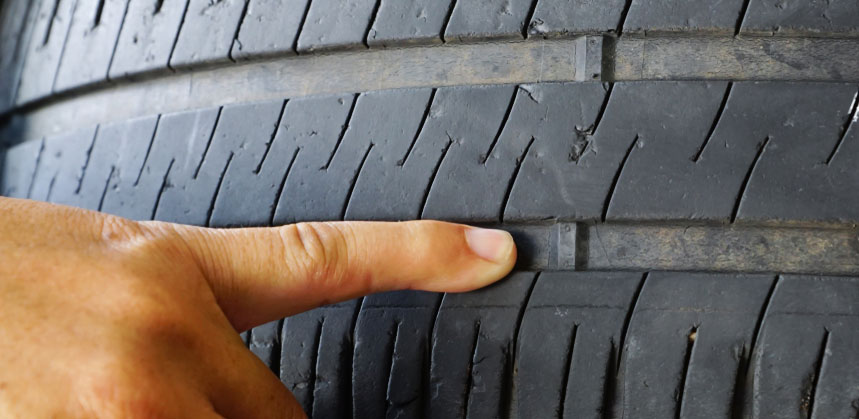 Add a few drops of dish soap and essential oil of your choice for fragrance.
Add a few drops of dish soap and essential oil of your choice for fragrance.
Shake the bottle well, spray the solution onto the tire, and buff it with a microfiber cloth. It will help protect your tires from harmful UV rays and keep them looking new for longer.
While cleaning the film off new tires can help to improve their appearance, there are some risk factors to consider. Here are a few things to keep in mind:

Overall, be sure to take appropriate precautions when cleaning your tires and choose appropriate methods for your specific tires and rims. If you need help with the best way to clean your tires, consult with a professional or tire manufacturer for guidance.
In conclusion, how to clean film off new tires is a relatively simple process and doesn’t take much time at all. Several methods can effectively remove the film from the tire, including an all-purpose cleaner and a cloth or brush. It’s essential to ensure that you’re using the right materials for the job and taking proper safety precautions when handling chemicals.
If done correctly, this should help you easily restore your tires to their original pristine condition. With these tips in mind, you should have no problem keeping your car looking great.
So you just bought brand new tires, but wait, why aren't they all black and shiny? Why do they look old and dirty? Could it be that they've given you old tires? Before more negative thoughts enter your mind, let us share with you the explanation given by the experts regarding those dirty-looking tires.
Your new tires look dirty because of the antiozonant residue on their surfaces. This is used by manufacturers to protect the tires from harmful ozone and UV rays. When exposed to the air, the antiozonant turns to a brown color that makes your tires look old. But by cleaning them properly and using tire protectants or tire shine, you can make them all black and glossy again.
Continue reading because we'll talk more about why your new tires look old. We'll also share with you how to clean your tires properly, how to make them black and shiny or just black if you don't want the glossy look. Let's also talk about whether those tire shine products do work and how they'll benefit your tires.
We'll also share with you how to clean your tires properly, how to make them black and shiny or just black if you don't want the glossy look. Let's also talk about whether those tire shine products do work and how they'll benefit your tires.
Before you continue reading, let us say we hope you find the links here useful. If you purchase something through a link on this page, we may get a commission, so thank you!
Take a look at the tires pictured above. The photo shows us tires that are all black and shiny. This is what we usually see on the ads, right?
But wait, this second photo below shows us tires that seem to have dirt on them. And guess what? Both pictures show us brand new tires. It may very well be a case of expectation vs reality.
There's an explanation behind this. Your new tires may look dirty and old because of the antiozonant used by manufacturers to give them added protection from different elements.
Antiozonant is a natural and organic compound that's usually added to rubber to prevent cracking caused by harmful ozone and UV rays.
In other words, manufacturers normally use antiozonant on their tires to make them last longer. This process is called tire blooming.
However, the antiozonant can eventually make its way to the sidewalls of your tires, and as it comes into contact with oxygen in the air, the color of its residue turns brown. This is due to oxidation which explains why your new tires look old and dirty.
Tire blooming may not look appealing, but it does wonders to your tires. It gives them defense from ozone cracking. They won't dry up and rupture when exposed to harsh elements which means they'll last longer.
If the dirty look of your tires bothers you, you can clean them to make them look better. Here's how to do it properly.
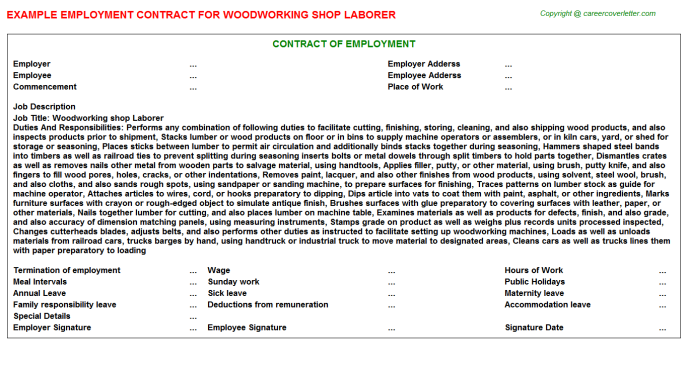 Make sure you cover all sides and remove the grime along the exterior and interior of the rim.
Make sure you cover all sides and remove the grime along the exterior and interior of the rim.That's it! Simple and easy, right? Do this at least once a month to remove dirt on your tires, keep them in tip-top shape, and make them look great all the time.
If you are not a fan of the shiny finish, you can make your tires look black by giving them a good cleaning. It's recommended that you use 50% cider vinegar and 50% water for your cleaning solution.
You can spray it on your tires then let it sit for a couple of minutes before rinsing and drying it with a clean towel.
The vinegar-water solution is natural, so there are no harmful ingredients that might adversely affect the surface of your tires.
Store-bought cleaning solutions may contain harmful substances or additives that can harm you or your tires. But going with mild liquid dish soap ensures you won't go wrong.
Follow the proper way of cleaning your tires mentioned earlier. Rinse thoroughly and make sure that there are no residues left on the surfaces. Allow them to dry completely, and you'll have clean black tires all the way!
If the brown residue of the antiozonant bothers you, there are ways for you to make your tires all black and shiny. Here's what you can do:
Here's what you can do:
Water-based protectants are considered more environment-friendly and won't cause any harm to the rubber over time.
Some even contain anti-UVR properties to protect your tires from harsh elements. Solvent-based tire dressings use silicone that's responsible for giving your tires that shiny look.
However, solvent-based protectants can make tires more prone to drying and cracking, especially those that contain petroleum distillate in their ingredients, so check the product information carefully before buying.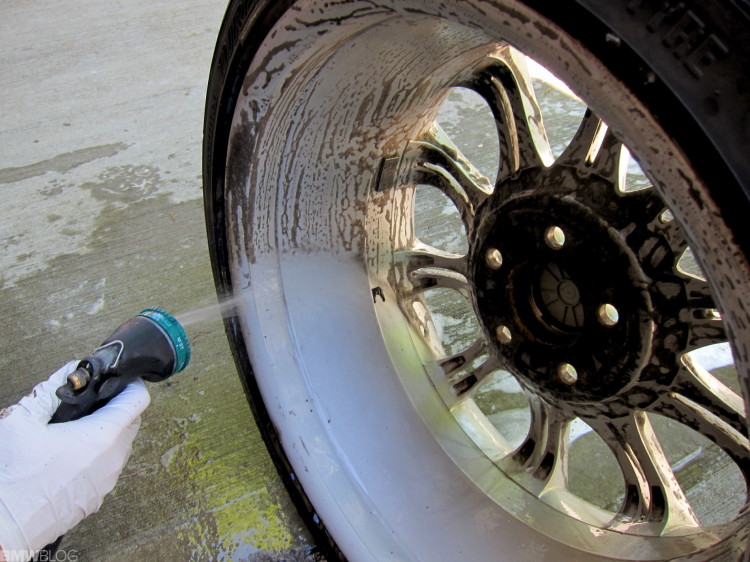
Tire protectants or dressing can come in bottle sprays or aerosols. You can spray or wipe it on your tire to enhance its protection against the elements.
They can revitalize or moisturize the rubber used on your tires, giving them a wet look and shiny finish which makes your tires look brand new.
But more than that, they will prevent color fading, cracking, and tire hardening. This means your tires will last longer, and that gives you more value for the money that you spent on your new tires.
Click here to see this water-based tire protectant on Amazon.
There are various tire protectants or tire shine products available in the market. Each one has a different claim on how long their luster will last. Some say that they'll make your tires glossy for a week while some promise long-lasting shine.
This is where it is especially useful to read customer reviews for their personal experiences regarding the product. You might as well do your research so you'll get the best value for your money while giving the best protection to your tires.
You might as well do your research so you'll get the best value for your money while giving the best protection to your tires.
Tire experts vouch for the usefulness of tire shine. They believe that it adds an additional layer of protection to our tires to help in maintaining the rubber quality. Since our tires are always subjected to abuse on the road, they need all the protection that they can get.
Tire shine doesn't only make your tires look cleaner and glossier, it also helps keep off dirt and other debris from accumulating on the surface. Some even come with anti-UVR properties that protect tires from harsh elements.
In the end, these products help prolong the service of your tires by ensuring they are in the best condition all the time.
Dry rotting or cracking of the rubber in your tires is caused by constant exposure to harsh UV rays. The rubber components start breaking down, the oils evaporate, and the sidewalls begin to harden and lose their flexibility, which leads to cracking.
Tire shine helps prevent dry rot by moisturizing the sidewalls. Choose one that offers UV protection to shield your tire from ultraviolet rays and ozone that are the real culprits in the breakdown of rubber.
Click here to see this UV protectant tire shine spray on Amazon.
Don't be too bothered when your new tires look brown and old. This is caused by the antiozonant used by manufacturers to protect your tires and make them last longer.
Just clean them properly using the right cleaning solution and some tire shine products to bring out their rich black and shiny appearance.
For more articles on proper tire care, take a look at these posts:
How To Store Tires On Rims – 4 Steps To Follow
Do Tires Degrade Over Time? Even When Not Used?
December 23, 2021 Likbez Adviсe
Follow these simple guidelines and your tires will last for many more seasons.
You can listen to the article. If it's more convenient for you, turn on the podcast:
Be sure to label each tire before removing the wheels from the car. In the next season, you can easily install them in their places and avoid premature wear due to uneven tread wear.
Mark the tires with a marker, chalk or stick stickers on them, indicating which of the wheels they were on. For example, "LP" - left front, "R" - right rear, and so on. If you use special storage cases, then they usually already have the appropriate labels. In this case, the main thing is not to confuse.
It doesn't matter if you want to store tires with or without rims - they must first be cleaned. And the point here is far from perfectionism, but the fact that prolonged exposure to abrasive particles from dirt, stuck pebbles and other foreign objects damages the tread and accelerates the aging of rubber.
Take a coarse brush and wash off all the dust, salt residue and other dirt accumulated inside the tread grooves. Inspect the tire surface for deep cuts and cracks. Remove stuck screws, nails and stones.
Inspect the tire surface for deep cuts and cracks. Remove stuck screws, nails and stones.
After water treatment, dry the tires until all moisture has completely evaporated. Otherwise, mold may form on the tire, and corrosion centers may form on the rim.
Don't forget to restore the marks if they are washed away!
To preserve the properties of rubber, it is advisable to cover the tires to protect them from sunlight and high humidity. As covers, both special purchased options and ordinary plastic bags or cling film are suitable.
Textile covers are made of breathable material that allows air to circulate. If you have these, then just put them on the tires. When constructing an impromptu protection from bags or cling film, leave small gaps to ensure natural ventilation. Otherwise, condensation may form inside, which will damage the tires.
Do not store tires anywhere. According to GOST, which regulates the handling of tires of all types, they should be stored in rooms with a temperature of -30 to +35 ° C and humidity in the range of 50-60%.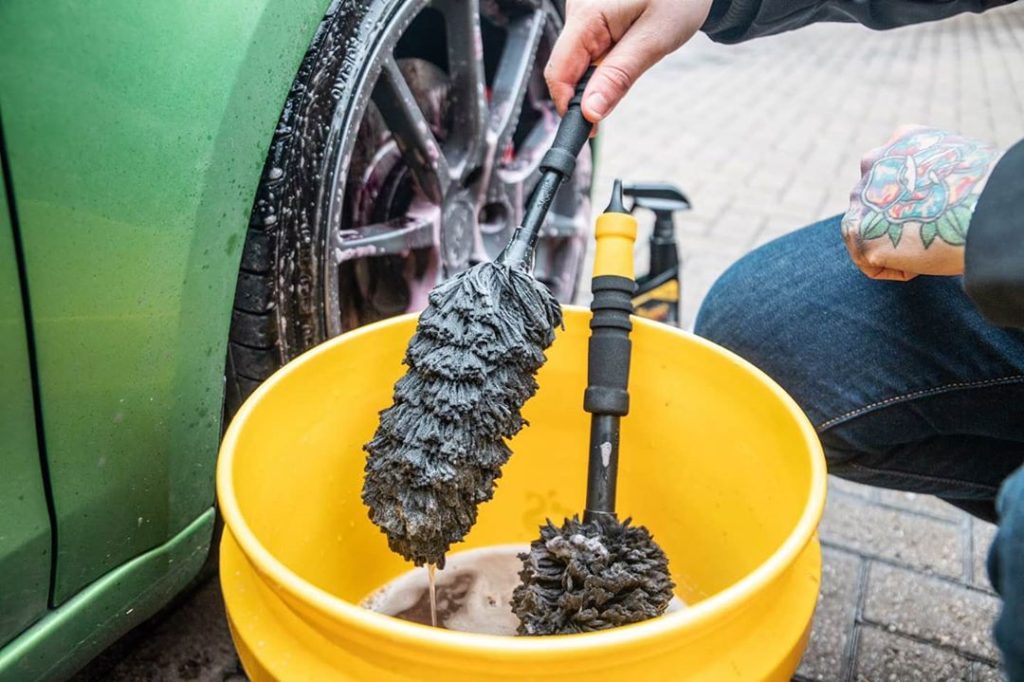 And also away from heaters, fuels and lubricants and ozone-producing devices.
And also away from heaters, fuels and lubricants and ozone-producing devices.
At home, the main enemy of rubber is ultraviolet radiation. The sun's rays dry out the material, which reduces its elasticity and leads to cracking. High humidity is also dangerous, but it is rare in everyday life. And providing insulation from containers with oil, gasoline, solvents and other chemicals is not so difficult.
The best option would be a garage, if there is good ventilation, a basement is also suitable. A balcony is the least preferred, but if there is no other way out, then at least protect the tires from the sun.
In addition to where the tires are stored, tire placement also plays a big role. There are several options for the correct placement of tires, depending on whether they are on rims or not.
Stack the complete wheels on a flat surface. It is impossible to place any objects on them, using them as a table or stand. If there is not enough free space, hang the wheels along the walls, hooking the rims of the disks with hooks. In both cases, lower the tire pressure by about half.
If there is not enough free space, hang the wheels along the walls, hooking the rims of the disks with hooks. In both cases, lower the tire pressure by about half.
If you don't have a second set of rims and you store the tires flat, stack them vertically in a single row. At the same time, once a month or so, do not forget to turn each tire a quarter of a turn to change the fulcrum and prevent deformation.
Read also 🚗🔧🧐
There is no less snow in Hokkaido than in Siberia. And if the main highways are regularly cleaned, then small city streets are covered with a thick and dense layer of snow and ice during the winter. Salt and sand are not favored here - they say that no reagents are enough for such an amount of snow. Clean, beautiful - but slippery. However, car traffic is not just busy, but, frankly, high-speed. Japanese taxi drivers start no less briskly than Moscow taxi drivers, but they drive much more carefully. What are the cars shod in here?
And if the main highways are regularly cleaned, then small city streets are covered with a thick and dense layer of snow and ice during the winter. Salt and sand are not favored here - they say that no reagents are enough for such an amount of snow. Clean, beautiful - but slippery. However, car traffic is not just busy, but, frankly, high-speed. Japanese taxi drivers start no less briskly than Moscow taxi drivers, but they drive much more carefully. What are the cars shod in here?
Since 1991, studded tires have been banned in Japan (not because of damage to the road surface, but for environmental reasons: without them, they say, there is less dust in the air). Therefore, in the presented line of new Yokohama tires, there are four Velcro and only one spike - an export version.
At low temperatures, when the ice is rough and dry, velcro can confidently beat spikes. Problems arise with small “minuses”, when a water film forms on the ice in the contact patch. The porous microstructure of the new iceGUARD tires is designed to remove it. The tread rubber contains many capillary inclusions and spherical microgranules that can be filled with water under pressure in the contact patch - thus, the tire absorbs the water film and the contact occurs directly with the ice. In addition, the microgranules have a relatively hard shell and its edges provide additional grip with ice. When a section of the tire disengages, water is removed from the pores under the action of centrifugal force.
The tread rubber contains many capillary inclusions and spherical microgranules that can be filled with water under pressure in the contact patch - thus, the tire absorbs the water film and the contact occurs directly with the ice. In addition, the microgranules have a relatively hard shell and its edges provide additional grip with ice. When a section of the tire disengages, water is removed from the pores under the action of centrifugal force.
A similar compound was used in the previous generation of tires - iG20, and the novelty of 2008 iG30 received, according to the developers, additional absorbent elements in the form of spatial microgrids; in addition, the granules-balls have become much smaller - the edge effect is more pronounced. The rigidity of the blocks has increased - the handling on dry land has become better (including due to three-dimensional lamellae).
To assess the grip properties of the rubber itself, the Japanese offered to ride on snow on slicks made of winter compound.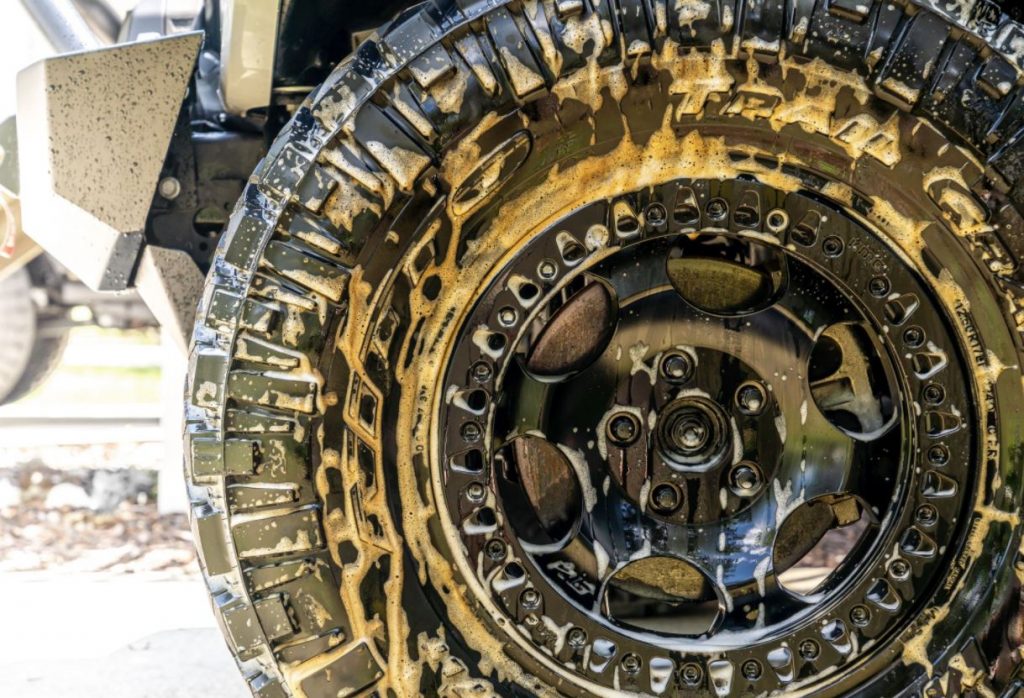 The sensations are unusual, but the car as a whole behaves even better than on summer tires with a tread: it accelerates confidently, brakes and even turns carefully. We were able to evaluate winter tires when braking on ice and on a slalom snow track.
The sensations are unusual, but the car as a whole behaves even better than on summer tires with a tread: it accelerates confidently, brakes and even turns carefully. We were able to evaluate winter tires when braking on ice and on a slalom snow track.
Details at www.zr.ru .
BMW-525 on high-speed non-studded W drive showed excellent handling on the snow. The stabilization system can sleep peacefully.
BMW-525 on high-speed non-studded W drive demonstrated excellent handling on the snow. The stabilization system can sleep peacefully.
Nissan-Qashqai on studded iceGUARD showed the shortest braking distance on ice from 40 km/h: about 35 m. iG stud tires are also available for SUVs.
Nissan-Qashqai on studded iceGUARD showed the shortest braking distance on ice from 40 km/h: about 35 m. iG stud tires are also available for SUVs.
"Toyota Land Cruiser", shod in Geolander all-terrain Velcro, could not compete with cars on the slalom track. But if you don't drive too fast, the grip is enough both on the ups and downs.
"Toyota Land Cruiser", shod in Geolander all-terrain Velcro, could not compete with cars on the slalom track. But if you don't go crazy, the grip is enough both on the ups and downs.
Nissan Infiniti with iG20 tires feels good on both snow and ice: braking distance is about 47 m.
Nissan Infinity with iG20 tires feels good on both snow and ice : braking distance approx. 47 m.
The new iG30 is easily recognizable by its Z-shaped center rib. On the track, the instructor made a mistake, suggesting a left turn instead of a right one in front of the ski jump. Thanks to the tires: they helped bring the Toyota Camry into that corner, although not without a skid.
The new iG30 is easily recognizable by its Z-cut center rib. On the track, the instructor made a mistake, suggesting a left turn instead of a right one in front of the ski jump. Thanks to the tires: they helped fit the Toyota Camry into that corner, although not without skidding.
The iG30 tire (right) absorbs water better than its iG20 predecessor.
Yokohama winter tires: Micro-shoes
Yokohama winter tires: Micro-shoes
Winter tires Yokohama: Shoes with micropork
Winter tires Yokohama: Shoes with micropork
Our new video
Big Lada, almost VW plans from Kaluga revealed automotive industry
So here's the thing! 7 imperceptible reasons for excessive fuel consumption
Frame, eternal diesel, LEDs, a bunch of chips .